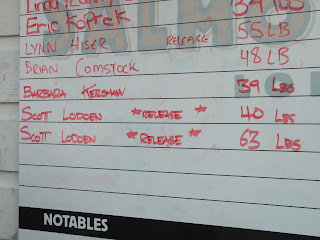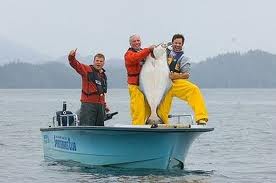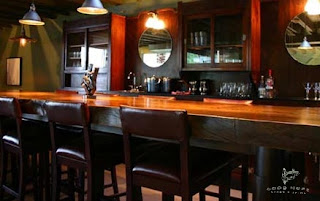Rivers Inlet Chinook
The Article below is courtesy of http://www.finefishing.com and has some good information on the Rivers Inlet fishing possibilities. The resorts offer a wide variety of services, quality and pricing, check the list at the bottom of the article. Some of the facts in the article are outdated, like saying the 70 plus pounder is the largest caught in BC, we all know that is not accurate. One or more of the lodges may have shut down so call around.
Rivers Inlet offers a lot more fishing opportunities than just salmon, check to make sure the lodge you choose has the capabilities to get you on Halibut, bass, cod and the other abundant species of the area.
A special breed of huge Chinook salmon, larger than any you've ever imagined, swims the Pacific Ocean among lesser, smaller Chinook. After binge-feeding and thoroughly fattening up like Sumo wrestlers, these super-weight Chinook finally feel the urge to find their way home to Rivers Inlet B.C.
Along the way a few anglers get lucky and catch a "Rivers" fish, but not like the anglers who fish the waters where these behemoths stack like cordwood, waiting to make their final voyage. A few years back, a lucky commercial troller working Hakai Pass, a short distance from the mouth of Rivers Inlet, hooked onto a whopping 126-pound Rivers Inlet Fish. Had a sports angler taken the brute, his or her name would likely be as famous as any angler alive. As for this season, I guarantee you won't want to miss this year's run, because it should be a reel-smokin', line-breaking, maybe even record-breaking season. With a little luck and proper timing, you could join the lucky few who annually greet one of the world's best strains of chinook salmon.
Bernie Porad of Mercer Island, WA with the largest salmon caught in BC at 70-plus pounds.
PHOTO CREDIT: JOHN BEATH
Terry Johnson, owner of Rivers Inlet Resort, says the run of large five and six year fish, the Chinooks that fill our dreams, should be stronger this year than in the past few years. Until you've seen one of these monster Chinook, or better yet, felt one on the end of your line, it's hard to imagine what a 45 to 80-pounder can do to your nerves and tackle.
Located roughly halfway up the western shores of British Columbia, Rivers Inlet cuts deeply into the rugged Coast Mountain range. Almost sheer cliffs carpeted green with fir and cedar and topped with snowy caps surround the deep inlet. In places the water reaches depths over 1,000 feet, and the side walls of the inlet stretch beyond 5,000 feet. The water flowing in and out of Rivers Inlet runs milky green from glacial silt. From the air the inlet looks like an artist went wild with blues and greens.
Each high tide brings more fish. Sometimes giant Chinook, sometimes jacks that weigh 20 pounds. The high tides also bring any one of the other four species of salmon. Anglers from around the globe come to Rivers Inlet with hopes of beating their biggest Chinook or beating the world record. Most of them do set their own records, but none have held on to the record yet, but it will happen says Johnson. "It will take someone who doesn't make any mistakes and someone who knows how to put a 100-plus pound Chinook into the net!"
Anglers at Rivers Inlet revere high tide and fish every last bit of it. As the tide brings more fish, the salty water beneath the freshwater layer on the top of the inlet provides an excellent acclimating source for fish heading to the Wannock, Kilbella and Chuckwalla rivers. The "salty zone" directly beneath the 10 to 12-foot layer of cloudy freshwater also provides the best opportunity for anglers to connect with the closest thing to a living torpedo that they've likely ever felt.
While the Chinook acclimate, they move up the inlet with the high tide and then wash backwards with low tide. As you can imagine, anglers don't miss low tides either! Simply having your line in the "salty zone" during any tide stage enables anglers to fish for new arrivals as well as not-so-recent arrivals.
The waters of the inlet are largely protected from the elements, rain excluded of course. But wind only blows in two directions here; from the east and west. Mornings almost always stay "parking lot puddle" calm, which bodes well with land-loving, sea-sickness prone people. If you have motion sickness, this is the place to fish. In the afternoons the winds usually do cause a bit of a bumpy ride, but nothing that a died-in-the-wool salmon fishermen can't handle. In fact, last season, while fishing alone from one of Rivers Inlet Resort's 14-foot Livingston boats, I hooked and landed a 52-pounder single-handed without any problems.
When one of these girthy Chinook takes the bait, it's unlike any other Chinook bite because you won't know how much the fish weighs until it's battled close enough to the boat to guesstimate the weight. Fishing with anything less than 30-pound test will result in lost fish - eventually. Even with 30-pound test, countless anglers lose once-in-a-lifetime trophies.
These fish are finicky at times, but when the bite comes on, look out. It's unlike anything you've ever witnessed. On several occasions, I've seen several fish on at the same time, all of which weighed 40 pounds. Last year a whopper 70-plus pounder, the largest Chinook taken in B.C., struck a bait within 50 feet of my boat. So close and yet so far... But I did have the chance! Few places on earth offer the opportunity to watch several anglers play huge chinook, all at the same time in the same general location. Double headers on your own boat can happen as well - it happened to several anglers last year, including me.
The largest hatchery Chinook {81 1/2 pounds} ever taken backs up the claim that Rivers Inlet has the most successful monster Chinook hatchery program in the world. Last season further backs the claim because the average Chinook taken by Rivers Inlet Resort guests weighed an unbelievable 47 pounds. No other resort or fish camp can make this claim to my knowledge.
This year, like most other years, anglers can expect their Chinook to top 40 pounds or more. Several resorts line the shores of the inlet all the way to the mouth of the inlet, where Rivers Inlet enters Queen Charlotte Sound. Chinook hotspots vary from resort to resort as well as "prime times" to fish them. Early in the season, before Rivers Inlet Resort begins its "prime time" 40-day season, lodges near the mouth of the inlet experience excellent fishing for smaller Chinook and bottomfish inside the inlet and in Queen Charlotte Sound.
Early runs of Chinook weigh less, but oftentimes push 30 pounds, the mark that designates them as "Tyee" in Canada. These fish are star-bright and return to the Killbella and Chuckwalla Rivers on the opposite side of the water from Rivers Inlet Resort. The Rivers Inlet Hakai Sport Fishing Association operates a fish enhancement program on these two rivers that benefits Rivers Inlet anglers in June, July and August as these fish move up the inlet toward the two rivers. As the season progresses, Chinook, coho, chum and sockeye move quickly past the steep shores of the inlet and past private boat anglers as well as guests from the lodges.
Most places this 47-pound salmon would highlight a season. At Rivers Inlet it's the average-size fish.
PHOTO CREDIT: JOHN BEATH
Prime Times For Trophy Chinook
If it's trophy chinook you're after, you will want to visit the area in mid-July through August. And, during this time, you have the best chance of hooking a trophy at the head of the inlet, where Rivers Inlet Resort is located. The waters either in front of Rivers Inlet Resort, within a rock's throw, or directly across from the resort, on the other side of the inlet yield the most trophy fish, year in and year out.
Technique, Trolling & Technique
Resort anglers fish from sea-worthy small outboard-powered boats ranging in size from 14 to 18 feet. Rivers Inlet Resort uses 14-foot Livingstons because of their stability when leaning over the gunwale with a net full of fish. They also use new-each-season Mercury 9.9 motors. You don't need more power as the action's very near the resort.
Depth, as mentioned previously, is critical. Since the milky green freshwater covers the top ten or more feet of saltwater, anglers must fish beneath the layer if they want to enjoy catching Chinook salmon. Depth of the bait usually ranges from 10 feet to 30 feet. The depth of the water could be 20 or 200 feet. The inlet angles steeply from the shoreline and gains depth rapidly. Most successful anglers stay within 100 yards of shore with less being better than more. In other words, the closer to shore the better. These fish tend to hug the shoreline most of the time when they're on the bite.
Successful anglers troll super slow or motor mooch, kicking the motor in and out of gear. Some anglers catch fish trolling at a quick clip, but the tried-and-true best method is to troll super slow which allows the massive bruisers the opportunity to suck down your flashy offering.
Two years ago, two anglers discovered the benefits of positioning a two-blade gang troll two feet in front of their cut-plug herring and behind their weight. Everyone laughed at them in the beginning, but quickly shut up after they hooked fish after fish. Later in the season, when hatchery personnel captured some spawners for the hatchery program, several of the largest fish, (one weighed over 70-pounds) had the same two-blade gang troll rigs still hanging from stainless steel hooks embedded in rock solid lips.
The most productive trophy Chinook bait, bar none, is jumbo cut-plug herring. If you know how to properly rig a whole herring, it's dynamite as well. Last season, using nothing but whole herring, I landed 12 Chinook over 40 pounds while fishing at Rivers Inlet Resort. The largest checked in at 60 pounds exactly!
Playing The Game Right
Don't set the hook on these monsters! I repeat, don't set the hook on these fish. A super-sharp hook is more important. Think of it like this; you have anywhere from 10 to 30 feet of line from the tip of your rod to the bait and hopefully a fish. If you set the hook when the fish sucks down your bait during a dine-n-dash pass, you loose when the rod and line meet 40 or more pounds of finned energy racing at top speed away from your boat. Your line and or your rod breaks.
A super loose drag will put more fish on the hook and in the net. Once you've lowered your bait, turn the clicker on and loosen the drag almost to the point line freespools off the reel. This is where your previous lesson pays off. When the fish hits, it takes the herring in its mouth and dashes away. The drag from the rod guides and friction from the water coupled with the fish biting down on the bait almost always embeds the hooks. Last year I boated every single fish hooked using this tried and true method.
After the bite, simply hold the rod high and head for the bow of the boat if possible. If the fish turns right or left, the boat will turn. Usually these big fish will run out 50 to 100 yards of line before stopping. Trying to slow them does little so just let them go and then chase them with the boat. If the fish goes straight down, and they almost always do at Rivers Inlet, take Terry Johnson's advice. "You have to give a little to get a little." Back the boat until the line angle increases. This gets the fish moving instead of playing a losing game of tug-o-war. The idea here is to let the fish burn out quickly for an effective release or netting job. Remember another one of Johnson's sayings, "You've got to float 'em before you boat 'em."
And of course, you may bring your favorite salmon fishing outfit if you like, but you need not worry because the resorts furnish top-quality gear with fresh line. Anglers should also note, in British Columbia, saltwater anglers may fish with as many rods as they can handle, provided everyone aboard has a valid license and Chinook stamp. Most anglers use two rods each - a definite bonus when trying for trophies.
Limits
The daily limit is two Chinook. Possession limit is four Chinook. Anglers may also catch two "other" species of salmon for their daily and possession limit. During coho season, mid August through September, it's not rare to see 20-pound coho. If you keep Chinook under 30 pounds or Coho under the teen mark, you may find yourself on the receiving end of a smirky smile!
Trip Facts
Anglers heading to Rivers Inlet Resort begin their trip in Renton Washington, near Seattle, where they board DeHavilan Beaver floatplanes on the south shores of Lake Washington. The flight north takes just under four hours with a stop in Nanaimo, on Vancouver Island, to clear customs. Anglers arrive at the resort, eat a hearty meal and fish or relax from 1pm to dark, around 9:30.
Anglers heading to one of the other lodges fly or drive to Vancouver B.C., where they catch floatplanes for the ride north. From Vancouver the trip north takes 2 1/2 hours.
Lodges
Rivers Inlet Resort.........................................{206} 226-4600
Rivers Lodge.................................................{604} 685-2127
King Salmon................................................. {800} 663-7090
Black Gold....................................................{604} 941-3228
Buck's Trophy Lodge....................................{604} 985-3638
Big Springs....................................................{800} 663-4400
Rivers Inlet Sportsman's Club.........................{604}264-7472
For more information and a free, complete B.C. travel kit, call Discover British Columbia at {800} 663-6000.




























